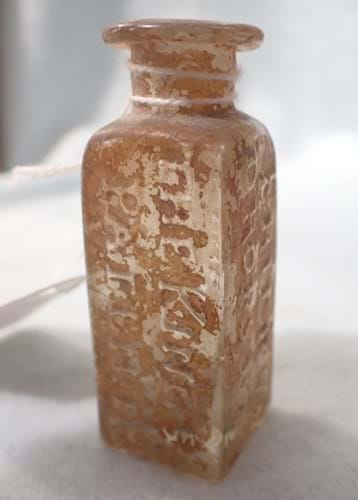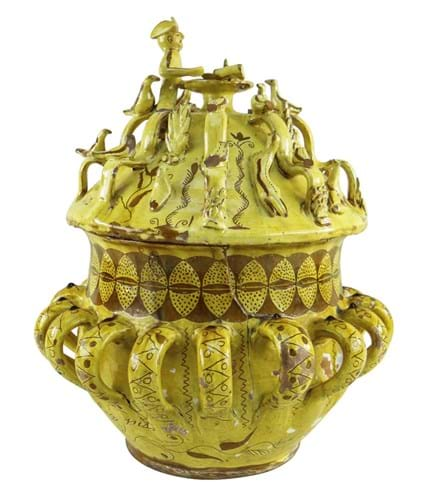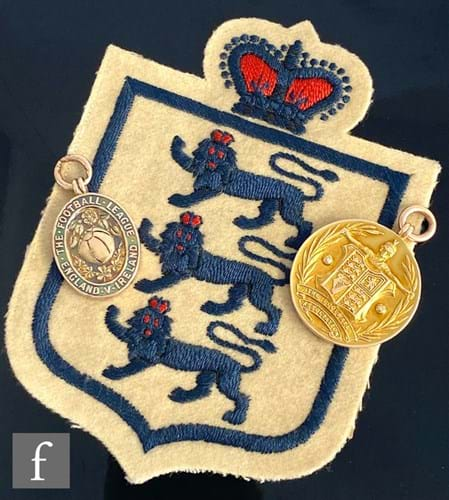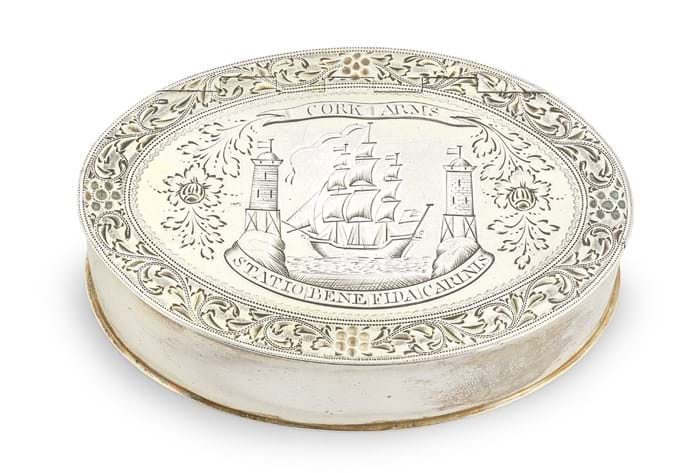1. Iron jizai okimono of a hawk – £42,000
This iron model of a hawk is a striking example of a jizai okimono – lifelike, articulated animal figures popular in the last decades of Edo-period and Meiji Japan. Many were made by the armourers and sword makers whose primary clientele had disappeared with the abolition of the samurai class in 1876.
Woolley & Wallis has offered a number of good examples in recent years including a jizai okimono of a dragon fish (£12,000 in 2019) and an unusually large snake signed Myochin (£40,000 in 2020).
There are only a small number of iron articulated hawks recorded. This 23cm high raptor, sold in Salisbury on July 27 for £42,000 (estimate £25,000-30,000), is constructed from numerous hammered iron plates that allow elements such as the head and wings to move. The eyes are inlaid in gilt with black pupils, the beak worked in shibuichi while beneath the wing feathers are concealed numbers.
It came for sale from the collection of the late Hubert René Joseph Georges Faure (1919-2020) whose first wife Elizabeth ‘Bessie’ de Cuevas was a great-granddaughter of John D Rockefeller.
A similar jizai okimono bird of prey by Myochin Kiyoharu is on display at Tokyo National Museum while Bonhams sold a spectacular 41cm example – the ‘Adjustable Iron Statue of Hawk' which had won a silver medal at the 1894 Spring Exhibition of the Japan Art Association – for £95,000 in May 2013.
2. Medicine bottle for ‘Friar's Drops’ – £2600
Unexpected bidding arrived at Duke’s Avenue saleroom in Dorchester on July 20 for a small medicine bottle inscribed Friar's Drops, By The Kings Patent Granted to R Grubb 1777.
It was in ‘dug’ condition still retaining accretions inside and out.
According to adverts of the time, Robert Grubb’s patent medicine Friar's Drops was promoted especially for its ability to cure venereal disease plus ‘scurvy, rheumatism, stranguary, and gleets’. The ingredients mentioned in the original patent were listed as ‘aquilia alba (or the white eagle), purging antimony, guaiacum wood, balsam of Peru, extracts of cicuta, white sugar candy, oil of sassafras, salt of tartar, gum Arabic and spirits of wine rectified’.
Another bottle of this type, dated c.1777-1800, is in the collection of the Museum of London but it appears to be very rare. Collectors of early medicine bottles (there are a surprisingly large number) targeted this example that was estimated at £50-100 but raced away to bring £2600.
It’s the sort of price reserved for rarities although some patent medicines from this period have made more: in 2016 BBR Auctions in Elsecar, North Yorkshire set a record for an empty English medicine bottle when a Victorian flask of ‘Dr Sibley’s Solar Tincture’ took £8200.
3. Ewenny pottery wassail bowl – £15,000
The Welsh sale at Rogers Jones in Cardiff on July 24 included, estimated at £3000-5000, this rare Ewenny pottery slipware wassail bowl and cover. The sgraffito decoration of figures and animals is accompanied by the inscriptions WIM Clay Pits 1833 and William James Tonyrevil Jany 12th 1832. It came from the collection of Gwyneth and the late Ieuan R Evans, authors of Ewenny – Potteries, Potters and Pots. After plenty of competition, it was sold at £15,000.
Wassail bowls such as this one, measuring 15in (39cm) high, were among the largest pieces made at the Ewenny potteries and were used at communal events and normally made for the village as a whole. William James in this case was probably the donor of the bowl rather than a custodian or owner.
In the South Wales News of April 30, 1892 a report refers to William Williams, a potter at Claypits who made wassail bowls in the 1820s for parishes at a cost of one guinea each.
4. FA international debut medal – £10,200
For a time in the 1930s players making their debut for England were given an option by the Football Association to receive a gold commemorative medal instead of their normal match fee.
An FA international debut medal awarded to Tom Grosvenor was sold for £10,200 at Fieldings in Stourbridge on July 21-23 as part of a lot also including various other items related to his career, estimated at £4000-6000.
Grosvenor, of Birmingham City, made that first appearance for the match England v Ireland played at Deepdale, Preston, on October 4, 1933.
In 14ct gold, it is inscribed The Football Association, FA International, and to the edge 1933-34, T. Grosvenor.
It was offered with a 9ct Football League Medal relating to the same match, Grosvenor’s three England caps and his number eight England football shirt, as well as further ephemera such as photographs, menus and press cuttings.
Grosvenor was born in Netherton and played for Stourbridge (where Fieldings is based) then Birmingham City. He was sold on to Sheffield Wednesday in 1936 for £2500 and finished his professional career playing for Bolton Wanderers.
In his three appearances for England in 1933 he scored twice.
5. Elizabethan wool merchant’s estate book – £11,000
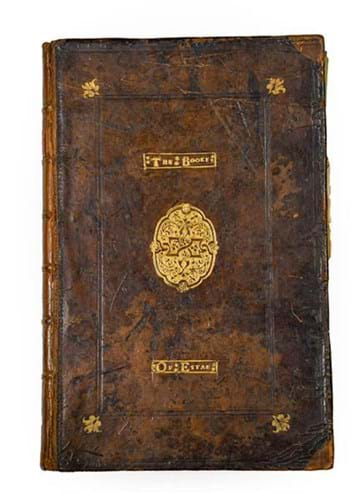
Elizabethan manuscript estate book of Thomas Cony of Bassingthorpe, Lincolnshire – £11,000 at Tennants.
This Elizabethan manuscript estate book of Thomas Cony of Bassingthorpe, Lincolnshire, c.1564-1608 came for sale for the first time since the 17th century at Tennants of Leyburn on July 28. The estimate was £2000-3000 but it brought £11,000.
This historical document revealing the domestic and commercial transactions of a powerful member of the English merchant class retains its original gilt Morocco binding in the Venetian style with the lettering 'The Booke Of Estat’. It was first brought to public attention by the noted antiquary Edmond Turnor (1754-1829), who published a selection of passages and an introduction in the proceedings of the Society of Antiquaries in 1794.
Turnor writes: ‘The book, contains, principally, notes of the cattle belonging to... Thomas Cony; inventories of his household-goods and plate at Bassingthorpe; his profits and losses in trade, etc. and the amount of his income and expenses for 54 years... He was the son of Richard Cony of Bassingthorpe, Esq. merchant of the Staple of Calais, who died in 1545, from whom he inherited a considerable property.
In 1573 he was high sheriff of Rutland... [His] line of trade, by which this great fortune was raised, was extremely lucrative. The merchants of the Staple had almost a monopoly of all wools exported; nor were the merchant adventurers [of whom Cony was also a member], who trade likewise in wools, a company less respectable’.
6. George III silver-gilt freedom box – £6000
Bonhams’ July 28 sale of Silver & Vertu included a number of Irish provincial pieces from the collection of Peter Ticher. It comprised many pieces that he had inherited from his father, Dr Kurt Ticher who, emigrating from Germany to Ireland in the 1920s, developed a keen interest in Irish Georgian silver, building up a large, important collection, some of it bequeathed to the National Museum of Ireland.
Peter, his eldest son, continued to add to his collection throughout his life.
Estimated at £7000-9000 but sold a little under hopes at £6000 was this George III silver-gilt freedom box by Carden Terry & Jane Williams, Cork. Dated 1798 it is engraved with the Cork city arms and is inscribed for Major General William Loftus (1752-1831), a British army officer and later MP.
A veteran of the American War of Independence, he was appointed commander in chief in Munster in 1798 and took command of Laughlinstown camp during the Irish Rebellion of 1798. It is sold with a related Freedom of the City of Cork scroll, inscribed to Major Loftus and dated ‘12th day of September 1809’.



